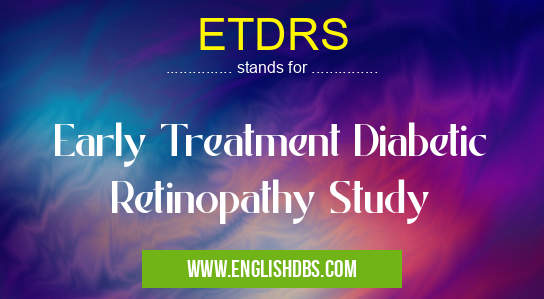What does ETDRS mean in NURSING
ETDRS (Early Treatment Diabetic Retinopathy Study) is a major clinical trial that investigated the effectiveness of laser photocoagulation in preventing vision loss in people with diabetic retinopathy (DR). The study was conducted by the National Eye Institute, part of the National Institutes of Health, and was published in 1985.

ETDRS meaning in Nursing in Medical
ETDRS mostly used in an acronym Nursing in Category Medical that means Early Treatment Diabetic Retinopathy Study
Shorthand: ETDRS,
Full Form: Early Treatment Diabetic Retinopathy Study
For more information of "Early Treatment Diabetic Retinopathy Study", see the section below.
Background
Diabetic retinopathy is a complication of diabetes that affects the blood vessels in the retina, the light-sensitive tissue at the back of the eye. DR can lead to vision loss and blindness if left untreated.
ETDRS Findings
The ETDRS found that laser photocoagulation was effective in reducing the risk of vision loss in people with proliferative diabetic retinopathy (PDR), a severe form of DR characterized by the growth of new blood vessels in the retina. The study also found that laser photocoagulation was less effective in preventing vision loss in people with non-proliferative diabetic retinopathy (NPDR), a less severe form of DR that does not involve the growth of new blood vessels.
ETDRS Recommendations
Based on the findings of the ETDRS, the American Academy of Ophthalmology (AAO) recommends that people with PDR receive laser photocoagulation to reduce their risk of vision loss. The AAO also recommends that people with NPDR be monitored regularly for signs of worsening disease and treated with laser photocoagulation if necessary.
Essential Questions and Answers on Early Treatment Diabetic Retinopathy Study in "MEDICAL»NURSING"
What is the ETDRS?
The Early Treatment Diabetic Retinopathy Study (ETDRS) was a groundbreaking clinical trial that investigated the effectiveness of various treatment approaches for diabetic retinopathy, a leading cause of blindness among people with diabetes. The study was conducted by the National Eye Institute (NEI) of the National Institutes of Health (NIH) from 1979 to 1985.
What were the main findings of the ETDRS?
The ETDRS demonstrated that laser treatment, specifically focal laser photocoagulation (FLP), was effective in reducing the risk of severe vision loss in patients with diabetic retinopathy. The study also showed that early treatment, before significant vision loss occurred, was crucial for optimal outcomes.
What are the implications of the ETDRS findings for people with diabetes?
The ETDRS findings emphasize the importance of regular eye exams for individuals with diabetes, as early detection and timely treatment of diabetic retinopathy can help preserve vision. The study also highlighted the effectiveness of laser treatment as a primary intervention for managing the condition.
What are the limitations of the ETDRS?
While the ETDRS provided valuable insights into diabetic retinopathy management, it had certain limitations. The study primarily focused on the use of FLP, and its findings may not be directly applicable to other treatment modalities, such as anti-VEGF injections. Additionally, the study was conducted over a limited time frame, and long-term outcomes beyond the study period may differ.
How has the ETDRS influenced the management of diabetic retinopathy?
The ETDRS findings have had a profound impact on the management of diabetic retinopathy. The study established FLP as the standard of care for the condition and led to the development of treatment protocols based on the severity of retinopathy. The ETDRS also influenced research efforts, leading to the exploration of new treatment strategies and the development of more advanced imaging techniques for monitoring diabetic retinopathy.
Final Words: The ETDRS was a landmark study that helped to establish the role of laser photocoagulation in the treatment of diabetic retinopathy. The study's findings have led to improved outcomes for people with DR and have helped to prevent vision loss and blindness in millions of people worldwide.
